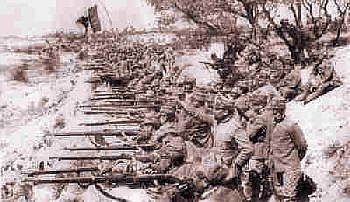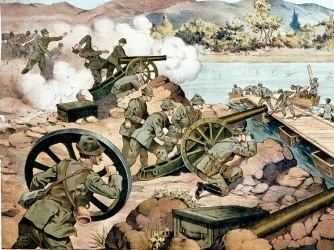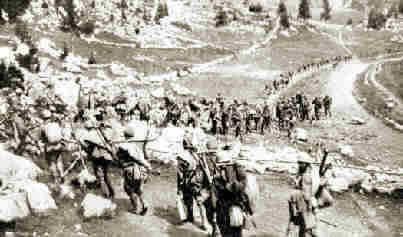Result Standoff | ||
 | ||
Similar Battle of Caporetto, Italian Front, Battle of Doberdò, Battle of Vittorio Veneto, Second Battle of the Piave | ||
Redipuglia and the isonzo front in ww1
The Battles of the Isonzo (known as the Isonzo Front by historians, and "soška fronta" by the territory's mainly Slovene population) were a series of 12 battles between the Austro-Hungarian and Italian armies in World War I mostly on the territory of present-day Slovenia, and the remainder in Italy along the Isonzo River on the eastern sector of the Italian Front between June 1915 and November 1917.
Contents
- Redipuglia and the isonzo front in ww1
- Italian military plans
- Geography
- Primary sector for Italian operations
- Casualties
- Number of battles
- References

Italian military plans

In April 1915, in the secret Treaty of London Italy was promised by Allies the territory of Austro-Hungarian Empire which were mainly inhabited by ethnic Slovenes. The Italian army wanted to penetrate in central Carniola, present-day Slovenia.

Italian Field Marshal Luigi Cadorna, a staunch proponent of the frontal assault, had plans of breaking into the Slovenian plateau, taking Ljubljana and threatening Vienna. The area between the northernmost part of the Adriatic Sea and the sources of the river Soča (Isonzo) thus became the scene of twelve successive battles.

As a result, the Austro-Hungarians were forced to move some of their forces from the Eastern Front and a war in the mountains around Soča river began.
Geography

The sixty-mile long Soča river at the time ran entirely inside Austria-Hungary in parallel to the border with Italy, from the Vršič and Predil passes in the Julian Alps to the Adriatic Sea, widening dramatically just few kilometers north of Gorizia, thus opening a narrow corridor between Northern Italy and Central Europe, which goes through the Vipava Valley and the relatively low north-eastern edge of the Kras plateau to Inner Carniola and Ljubljana. The corridor is also known as the "Ljubljana Gate".
By the autumn of 1915 one mile had been won by Italian troops, and by October 1917 a few Austrian mountains and some square miles of land had changed hands several times. Italian troops did not reach the port of Trieste, the Italian General Luigi Cadorna's initial target, until after the Armistice.
Primary sector for Italian operations
With the rest of the mountainous 400-mile length of the Front being almost everywhere dominated by Austro-Hungarian forces, the Soča (Isonzo) was the only practical area for Italian military operations during the war. The Austrians had fortified the mountains ahead of the Italians' entry into the war on 23 May 1915.
Italian Chief of Staff Luigi Cadorna judged that Italian gains (from Gorizia to Trieste) were most feasible at the coastal plain east of the lower end of the Soča (Isonzo). However he also believed that the Italian army could strike further north and bypass the mountains either side of the river so as to come at the Austro-Hungarian forces in the rear.
Not that he expected operations in the Isonzo sector to be easy. He was well aware that the river was prone to flooding – and indeed there were record rainfalls during 1914–18.
Further, when attacking further north the Italian army was faced with something of a dilemma: in order to safely cross the Soča (Isonzo) it needed to neutralise the Austro-Hungarian defenders on the mountains above; yet to neutralise these forces the Italian forces needed first to cross the river – an obstacle that the Italians never succeeded in overcoming.
In the south (along the coastal zone) geographic peculiarities, including an array of ridges and valleys, also gave an advantage to the Austro-Hungarian defenders.
Casualties
Despite the huge effort and resources poured into the continuing Isonzo struggle the results were invariably disappointing and without real tactical merit, particularly given the geographical difficulties that were inherent in the campaign.
Cumulative casualties of the numerous battles of the Isonzo were enormous. Half of the entire Italian war casualty total – some 300,000 of 600,000 – were suffered along the Soča (Isonzo). Austro-Hungarian losses, while by no means as numerous were nevertheless high at around 200,000 (of an overall total of around 1.2 million casualties).
More than 30,000 casualties were ethnic Slovenes, majority of them being drafted in the Austro-Hungarian Army, while Slovene civil inhabitants from the Gorizia and Gradisca region also suffered in many thousands because they were resettled in refugee camps where Slovene refugees were treated as state enemies by Italians and some thousands died of malnutrition in Italian refugee camps.
Number of battles
With almost continuous combat in the area, the precise number of battles forming the Isonzo campaign is debatable. Some historians have assigned distinct names to a couple of the Isonzo struggles, most notably at Kobarid (Caporetto) in October 1917, which would otherwise form the Twelfth Battle of the Isonzo.
The Isonzo campaign comprised the following battles:
